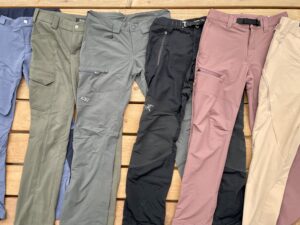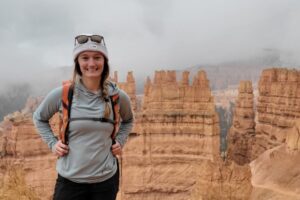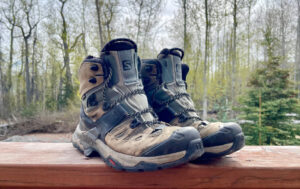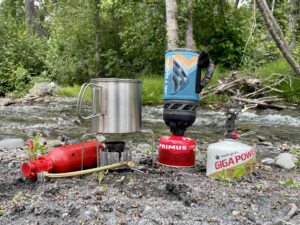New gear is always exciting whether you’re a backcountry skier, resort rider, or you like to do a little bit of both. We’ve included binding options for all kinds of skiers, from resort rippers to ultralight ski mountaineers. There’s so much new technology coming out each year, and bindings keep getting lighter and lighter.
Ski bindings hold your boot to the ski. That might not sound like the most interesting piece of equipment, but getting the right one can make a massive difference in your skiing. For beginner skiers, it’s really just about connecting your boot to the ski and making sure it comes off in a crash before you twist your leg. But for advanced skiers, the strength and flexibility of your binding are critical. If you’re flying down the mountain and hitting the ground hard, you need the binding to be able to cope with that.
Additionally, ski touring bindings have their own host of features and specs to dive into and we’ve even included a pair of shift bindings for those who need a one-ski-quiver for the resort and backcountry riding.
The best ski bindings
Editor’s Choice: DPS R10 Touring Binding

- Brakes included
- 300g weight
- Two heel risers
- Stomp pad for better power transfer and control
Pros:
- Exceptional downhill performance and sensitivity
- Easy adjustment via buttons, no tools needed
- Individually controlled release values
- Lightweight
- Included brakes
Cons:
- Not the lightest binding on the market
- Smaller travel range than other bindings
The DPS R10 is an exceptional touring binding with a weight that never bogged me down on the uphill and is loaded with plenty of features that made my downhill ride feel better than ever. At first glance, this model seems like a blend of tech bindings and alpine bindings, and there are elements of both here.
This binding is very sensitive, and each movement translates into the ski well. Part of this is thanks to the stomp pad instead of the heel of your boot engaging exclusively with the heel piece as in other classic tech bindings. When skiing steeper or higher consequence terrain, I felt significantly more confident with these bindings than I have with other models.
I love that you don’t need a screwdriver to adjust the heel piece and the quick engagement of the brake. These easy-to-use features can be engaged using the buttons while wearing a glove or glove liner. There are also two heel risers to reduce the load on your calves during steep ascents.
Many touring bindings lack DIN settings or individual release ranges, but not the R10s, these feature an individually controlled release value between 5 and 10. These weigh 300g and so aren’t the lightest on the market. However, they weigh significantly less than their counterparts with similar features.
See DPS R10 Touring Binding on Cripple Creek Backcountry
Best for Advanced Skiers: Marker Jester ID Ski Bindings

- Compatible with alpine and touring boots
- Easy to step into toe and heel piece
- Great for aggressive skiers and terrain
- 6-16 DIN range
Pros:
- Perfect for aggressive and freeride skiers, also works for park skiing
- Easy to use and step into
- Excellent safety features
Cons:
- DIN range isn’t appropriate for light or young skiers
- Not appropriate for new or intermediate skiers
The next binding is really getting into expert skier territory. At nearly $300, it’s more expensive than many alpine ski bindings on our list, but if you’re serious about your equipment, you should consider this one.
Expert skiers know the importance of having a high-quality binding: it is the main thing keeping you safe on the slopes and can enhance your downhill performance. You need to have the right settings for your weight, height, and skill level. Plus, you need to know it can take an impact. The Marker Jester ID Bindings are trusted by many great skiers.
This binding has a super versatile design to handle all types of terrain. Alpine skiers who are just as comfortable hitting a big jump in the park as they are tearing down steep sidecounty terrain will love this binding. This model has Marker’s Sole ID technology, offering boot compatibility with standard alpine boots and AT boots with lugged soles. Because this binding is for a more advanced skier, the DIN range is higher at 6-16. That still leaves room for adjustment and will comfortably accommodate pretty much any style of skiing. It also has a inter-pivot heel system, which makes the binding easy to step into.
One of the main attractions of this binding is its toughness. It is made from super strong magnesium parts that can withstand some serious impact and abuse.
See Marker Jester ID Ski Bindings on Amazon
See Marker Jester ID Ski Bindings on Backcountry
See Marker Jester ID Ski Bindings on EVO
Fast and Light: Dynafit Superlite 150

- Starting weight of 150g each
- Plenty of aftermarket add-ons to customize the binding
- DIN range of 4-13
- Four walk modes
- Great for ski racers, big objectives, or more casual touring
Pros:
- Extremely lightweight
- Great for racing or generally moving quickly
- Extremely adaptable
Cons:
- Not as strong downhill performance as some other bindings
- Difficult to adjust walk modes or risers with a ski pole
The Dynafit Superlite is one of the lightest ski bindings on the market, the true epitome of fast and light, and a great choice for skimo racers. There’s a fully adjustable side release DIN from 4-13 but that isn’t certified by a third party, yet impressive for such a light binding. The bindings weigh approximately 150g, with mounting screws and aftermarket add-ons this number does change slightly, but they are still remarkably lightweight.
There are four walk modes accessed by spinning the binding and/or flipping a riser. Aftermarket options include adding a brake, crampon, and a heel adjustment plate. All in all, we love how modular and adaptable these bindings are while keeping weight down.
See Dynafit Superlite 150 on Amazon
See Dynafit Superlite 150 on Cripple Creek Backcountry
Great for Young Rippers: Marker Griffon 13 ID Ski Binding

- Great for young or lightweight skiers
- Perfect for freeride skiers who love to express their ski style
- Exceptional downhill performance on steep terrain
- Compatible with touring and alpine boots
- Alpine gripwalk compatible
Pros:
- Perfect for lighter skiers
- Great for youth skiers who want to charge hard terrain
- Compatible with touring and alpine boots
- Aggressive skiers will love the sensitivity
Cons:
- Not ideal for recreational skiers or heavier skiers
From the picture, it’s really hard to tell the difference between the Marker Jester and the Marker Griffon Bindings. This binding is the lightweight version of the Jester. It has almost all of the same features but is designed with younger, lighter skiers in mind. But don’t be fooled by the fact that these bindings are designed for ‘young’ skiers, they are still advanced to expert bindings. If you are going skiing for the first time, these bindings are not right for you.
As the Jester, it features Marker’s Sole ID technology. You can easily adjust the slide plate to fit both alpine and touring boots. Not many bindings feature this sort of versatility. It also features the inter-pivot heel, which makes it super easy to step in and out.
One of the main differences between this binding and the Jester is the compact mounting and cross-toe axis spring. Without boring you with the technology behind this, these bindings are ideal for spins and twists.
They’re a bit cheaper than the Jester bindings but will still set you back well over $100. This puts them towards the higher end of bindings.
See Marker Griffon 13 ID Ski Binding on Amazon
See Marker Griffon 13 ID Ski Binding on REI
See Marker Griffon 13 ID Ski Binding on EVO
Best all-in-one: Salomon S/Lab Shift MNC 13 Alpine Touring Ski Binding

- Excellent terrain feedback and control on the downhill
- Tech toe for uphill travel
- Compatible with alpine and touring boots
- Multi-norm certified
- Automatic wing adjustment
- Toe height adjustment for switching between boot norms
Pros:
- Allows you to ski both the resort and backcountry with one binding
- Cost-saving
- Great terrain feedback on the downhill
Cons:
- Heavier than most backcountry bindings
- Shift bindings often “act up” or freeze up and can have longer transition times
- More adjustments and settings mean more points of failure
Skiing is an expensive sport, and for many, owning multiple sets of skis is unrealistic. So, having a pair of skis and bindings that allow you to shred in the resort and travel in the backcountry is a must. Generally, there are three options: learn to telemark ski, get a pair of frame bindings that are a bit outdated, or get a pair of shift bindings. If you need a one-ski quiver and are willing to compromise a bit in the resort and in the backcountry, a pair of Saloman S/Lab Shift MNX 13 Alpine Touring Ski Bindings are a great choice in the realm of shift bindings.
These are a newer binding model and have expert skiers in mind, they allow you to go big with plenty of elastic travel for minimal risk of pre-release. The binding itself is multi-norm certified and the toe piece is alpine gripwalk compatible, but there’s also a tech toe for touring boots for uphill travel.
The oversized platform and low-profile chassis allow for excellent terrain feedback and better control on the downhill, and freeski brakes are built-in. All in all, expert skiers who want a single ski to do it all will love this binding.
See Salomon S/Lab Shift MNC 13 Alpine Touring Ski Binding on EVO
See Salomon S/Lab Shift MNC 13 Alpine Touring Ski Binding on REI
See Salomon S/Lab Shift MNC 13 Alpine Touring Ski Binding on Amazon
Great for intermediate skiers: Salomon STH2 WTR 13 Ski Bindings

- Modern easy step-in features and self-retracting brakes
- Excellent power transfer thanks to a low-profile chassis, stomp pad, and XL wings on the toe piece
- Great terrain feedback
- Perfect for intermediate to budding advanced skiers
Pros:
- Very responsive and sensitive
- Great for young or light-weight skiers
- Secure toe piece
- Excellent all-around downhill performance
Cons:
- May be overly sensitive for newer riders
- Once the skier is solidly in the advanced range, a new binding is warranted
For the intermediate skier who wants a dependable binding with some of the classic features of the Salomon STH16 but with a lower din, we’ve got the Salomon STH 2 WTR 13. It has all the same good points but is better for those who are charging blue runs and developing their steep skiing skills to tackle black diamonds. The multi-directional release ensures your binding releases in all kinds of falls.
The large wings and stomp pad allow for better engagement with your ski boot soles, offering better control and power transfer into the ski. The low profile chassis also assists in ensuring you get the most out of each movement. There are self-retracting brakes and it features easy step-in. This is a great binding with excellent downhill performance on everything from an all-mountain ski to wider powder skis.
See Salomon STH2 WTR 13 Ski Bindings on Amazon
See Salomon STH2 WTR 13 Ski Bindings on EVO
Best all-around touring binding: Atomic Backland Tour Alpine Touring Bindings

- Step-in aid to assist with locking in the toe piece
- Built-in brakes
- Crampon compatible
- Great with wide skis
- Lightweight while offering plenty of features
- Two heel risers
Pros:
- Lots of features
- Easy to step into
- Great with wide skis
Cons:
- Limited release adjustment
The Atomic Backland Tour is a great all-around touring binding that’s loaded with plenty of features while remaining lightweight enough to be comfortable on the uphill. While we highly recommend this model as a great binding for newer backcountry skiers because of its ease of use and durability, it’s just as excellent for those who have been skiing for years.
The step-in aid in the toe piece will eliminate a lot of frustration, especially early on in your backcountry skiing career. There are two easy-to-use heel risers for steep ascents, brakes included, and these are crampon compatible. Some other features we love include the broad mounting for excellent power transfer even on wide skis, and the long 50mm sole adjustment.
See Atomic Backland Tour Alpine Touring Bindings on Amazon
See Atomic Backland Tour Alpine Touring Bindings on Backcountry
See Atomic Backland Tour Alpine Touring Bindings on EVO
Best for expeditions and big mountain skiing: Dynafit Expedition Binding
- 7.1oz or 7.4oz weight, great for fast uphill travel
- Low stand height and wide toe piece for more power transfer
- Simple and easy-to-use heel piece
- Forged 7075 aluminum construction
- No lateral release
Pros:
- Excellent for fast and light travel, expeditions, and big mountain skiing
- Great power transfer into the ski
- Simple heel piece
Cons:
- Only one heel riser, which could tire your calves during steep ascents
- No brake slot, leashes sold separately
The Dynafit Expedition Binding is an extremely lightweight touring binding designed to be fast and light, but it offers exceptional security for steep descents. This minimalist binding is great for big mountains, expeditions, and long days outside. It’s a classic fast and light ski binding, weighing 7.1oz without a crampon slot and 7.4oz with a crampon slot. The heel piece is exceptionally minimal, which also makes it easy to use, with a design borrowed from Randonnee race bindings.
Big expeditions and steep skiing often come with no fall zones and the lack of lateral release gives you extra security when it’s time to move confidently. The minimal design and wide toe piece work together to offer a low stand height which keeps you closer to your ski, offering more power transfer and giving you more control.
See Dynafit Expedition Binding on Amazon
See Dynafit Expedition Binding on Moosejaw
See Dynafit Expedition Binding on Backcountry
Why trust us
Our team’s love for snow, mountains, and skiing can not be understated. Cumulatively, we have decades of experience skiing and exploring the mountains. Extensive market research and conversations with the ski community help us identify patterns and common favorites to bring you the best downhill ski bindings and the best bindings for alpine touring.
Who this is for
This guide is for all types of skiers, whether you’re a resort ripper or prefer alpine touring. That said, this guide focuses more on backcountry skiing. Most beginner and intermediate skiers may not be diving into the complexities of ski bindings too early in their ski careers. With that in mind, this guide best serves ski mountaineers, more advanced resort skiers, folks who want a one ski quiver, and backcountry skiers.
How we picked
Selecting the best bindings was a mix of extensive market research, time spent skiing and testing, and polling experienced skiers, professionals, and friends.
How we tested
When testing the best ski bindings, it’s important to ride in a wide variety of terrain, from mellow to steep, and from ice to powder. Our tested models were used in the Cascades and in Colorado by a couple of of different riders to ensure we had multiple opinions. We skied all sorts of conditions, inside the resort, in side-country, and backcountry terrain.

Ski bindings buying guide
Here are a few key terms to understand before choosing your perfect binding.
DIN setting
Also known as Release Force Setting, this is the measure of how much force it takes to release your boot from the binding. It’s based on your weight, height, and ability. This allows more aggressive skiers to ski steep terrain without releasing from their skis and keeps beginner skiers from staying locked into their skis and causing knee injuries or broken legs in a crash.
Binding plate (or baseplate)
This is part of the binding that touches the ski. Baseplates are usually only seen on classic downhill bindings for resort skiing, although some hybrid bindings will feature baseplates as well, like frame bindings and shift bindings.
Toe plate
The part of the binding that the front of your boots fastens into. The toe plate or toe piece can offer a variety of ways to attach to your boot. Pin bindings attach via two pins and are used for backcountry skiing. Resort skiers will attach to the toe piece via the shape of the front of the boot, you’ll notice a lip at the front that inserts easily.
Heel piece
The part of the binding that the heel of your boots fastens into.
Heel friction device
Allows your boot to release from the binding without friction.
Brake
Brakes are arms attached to the heel piece of your binding that stick out your ski’s side. Not all brakes are the same width, so you will have to check that the binding will fit your ski. Not all bindings come with brakes but most resort skiers who ski alpine bindings will find brakes on their bindings.

Ski bindings FAQ
Q: Why are there wide brake bindings?
Some bindings have different-sized brakes to accommodate different-sized skis. In recent years, all-mountain and freestyle skis have been getting wider and wider, and old-style bindings couldn’t accommodate them. To check if your bindings will fit your skis, just measure them at the point where you’ll attach the bindings and make sure it’s smaller than the brake width.
Q: Why do alpine bindings have brakes?
Don’t be fooled by the fact that they’re called brakes, they’re not used to stop your skis or slow yourself down. They are to stop your skis from slipping away when you’ve come out of your ski. When you take your ski out of its binding, the lever digs down into the snow and keeps your ski in place. Many touring bindings either come with brakes or brakes can be installed.
Q: How do I know what DIN setting I need?
Every ski will have a DIN range. Normally, the DIN range on adult skis will be around 3-10. Your perfect DIN setting is determined based on your weight, height, and skill level. It should only be set and adjusted by a trained technician. However, some folks who are very experienced with their gear can make these adjustments themselves. Keep in mind not all touring bindings come with DIN settings.
Q: Do skis come with bindings?
If you rent your skis, they will come with bindings. Many beginner and intermediate skis will come with bindings already fitted, but not always. If you buy skis second-hand, they often come with bindings as well.
However, when you get to the point of buying brand-new ski gear, skis generally do not come with bindings and you will need to purchase these separately and have a ski shop mount them for you. You can mount your own bindings but we recommend doing this with an experienced friend first.
Q: How do I know if my boots will fit?
All alpine ski boots will be compatible with downhill ski bindings. The only problem occurs with touring boots. Touring and alpine bindings will display a range of boot sole compatibility and boot sole lengths (BSL) compatible within the tech specs. You can find your BSL on your boot or on your boot manufacturer’s website.
Some more expensive boots are compatible with alpine and touring boots, but this isn’t a blanket rule. If you are concerned about your boots fitting, you should be able to check the tech specs on the manufacturer’s website and compare it to your boot’s BSL or Boot Sole Length, and this is considered your boot sole compatibility.
Sources:
- Glossary – Snowsports – Blister Review
- Easy Going: The Revolution In Ski Boot Soles – Grip-Walk






